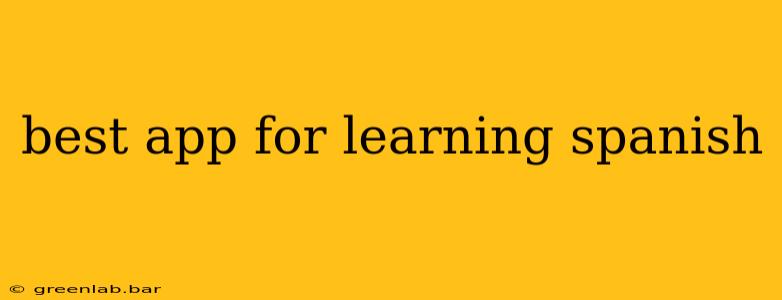Learning a new language can be a rewarding journey, opening doors to new cultures and experiences. Spanish, with its rich history and widespread use, is a particularly popular choice. But with so many language learning apps available, choosing the best one can feel overwhelming. This guide will delve into the top contenders, helping you find the perfect app to match your learning style and goals. We'll explore their strengths and weaknesses, ultimately empowering you to make an informed decision.
Factors to Consider When Choosing a Spanish Learning App
Before diving into specific apps, let's outline the key factors to consider when making your choice:
- Learning Style: Are you a visual learner, preferring images and videos? Or do you thrive on interactive exercises and gamified challenges? Some apps cater better to specific learning styles than others.
- Budget: Many apps offer free versions with limited content, while others require subscriptions for full access. Consider your budget and the features you're willing to pay for.
- Level: Are you a complete beginner or do you have some prior knowledge of Spanish? Choose an app that aligns with your current proficiency level. Some apps cater specifically to beginners, while others offer advanced courses.
- Features: Look for features like speech recognition, personalized learning paths, progress tracking, and community features. These can significantly enhance your learning experience.
- Content: The quality and variety of the content are crucial. Does the app offer engaging lessons, authentic materials, and opportunities for real-world application?
Top Spanish Learning Apps Reviewed
Here's a detailed look at some of the most popular and effective Spanish learning apps:
1. Duolingo: Gamified Learning for Beginners
Strengths: Duolingo is incredibly popular due to its gamified approach. It makes learning fun and engaging with points, streaks, and leaderboards. The app is free to use (with optional paid features), and its lessons are well-structured, making it ideal for beginners.
Weaknesses: Duolingo's focus on gamification can sometimes overshadow the depth of grammatical explanations. While great for vocabulary building, it might not be sufficient for mastering complex grammar rules.
2. Babbel: Comprehensive Lessons and Real-World Context
Strengths: Babbel offers a more structured and comprehensive approach to language learning than Duolingo. Its lessons focus on practical communication skills and incorporate real-world scenarios. The app provides personalized learning paths and emphasizes speaking practice.
Weaknesses: Babbel is a subscription-based app, and the cost can be a barrier for some learners.
3. Memrise: Mnemonics and Engaging Content
Strengths: Memrise utilizes mnemonics and memorable images to help learners retain vocabulary. It also offers a diverse range of content, including videos and flashcards, making it engaging and suitable for various learning styles.
Weaknesses: Like Duolingo, Memrise might not offer as in-depth grammatical explanations as other apps.
4. Rosetta Stone: Immersion and Interactive Exercises
Strengths: Rosetta Stone is known for its immersive approach, focusing on building fluency through context and repetition. Its interactive exercises are designed to simulate real-world conversations.
Weaknesses: Rosetta Stone is a premium app with a relatively high subscription cost. It might not be the best choice for learners who prefer explicit grammar explanations.
Choosing the Right App for You
Ultimately, the best app for learning Spanish depends on your individual needs and preferences. Consider the factors we discussed earlier—learning style, budget, level, features, and content—to determine which app aligns best with your goals. Many apps offer free trials, allowing you to test them before committing to a subscription. Don't hesitate to try a few different apps to find the one that keeps you motivated and engaged in your Spanish learning journey. The key to success is consistency and finding a learning method that you enjoy!

